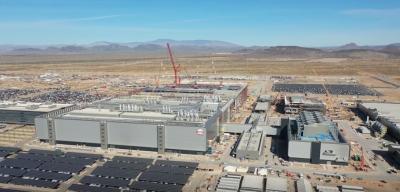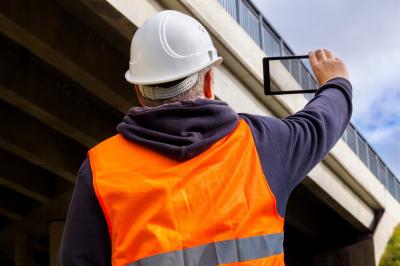There is a bridge on Route 1 in Mendocino County that travels over a wide river. It is beautiful, scenic and peaceful — but it is also dangerous, as it is susceptible to collapse during an earthquake.
In fall 2010, it will be gone. In its place, Golden State Bridge Inc. is constructing a new bridge just 60 ft. (18.2 m) east of the old one. The new bridge will be a 1,479- by 44.9-ft. (451 by 13.7 m) impressive concrete structure with two 12-ft. (3.7 m) lanes and two 6-ft. (1.8 m) shoulders. Most importantly, it will be earthquake-safe.
“The current bridge was constructed in 1954, and has been identified as susceptible to collapse during a Maximum Credible Earthquake [MCE] of moment magnitude 8.0,” said Phil Frisbie Jr., public information officer of Caltrans, District 1. “The collapse of this bridge would impact public safety and the local economy.”
Enter District 1 of Caltrans, who, in 2006 let a contract to Golden State Bridge Inc. for $43,530,205 to construct the new bridge. The project began in January 2007, when the company began clearing vegetation and constructing access roads and trestles.
Golden State used many pieces of equipment including two Grove HL 150C cranes, a Grove RT650 crane, a Cat 966G loader, a Komatsu PC600 excavator, a Cat IT38G loader, a Zoom Boom 20044 forklift, a Case 580 backhoe, a Bobcat 863 skid steer, a Delmag 46-32 Diesel hammer and an H&S 4450 vibratory extractor.
“The two Grove HL 150C cranes were critical for our everyday work,” said Cu Mai, project manager of Golden State Bridge. “The cranes were essential in constructing the temporary 1,200-foot long trestle, installing six large cofferdams and pile driving 30-inch diameter steel piles.”
Mai also said, “The Zoom-boom forklift was another valuable and versatile [piece of] equipment, especially for removing falsework. The 20,000-pound capacity allowed us to reach and remove material we normally never would have been able to with a normal forklift.”
According to Frisbie, Golden State is doing an excellent job constructing the bridge.
“The contractor is ahead of schedule and their workmanship has been compliant with the plans in all respects,” he said. “They have been exceptionally diligent and cooperative with resource agencies protecting endangered species and their sensitive habitats and at resolving construction problems that inevitably occur on any project of this magnitude.”
But before the project got rolling, there were several issues Caltrans had to address.
Environmental Concerns
Noise ordinances for humans are more and more common these days. But most places don’t have regulations for fish. The Ten-Mile River project is an exception.
“They did some research and found that loud noises shock the fish,” Mai said.
What effect does this have?
“Depending on the level of noise and the size of the fish, they can be mortally injured, temporarily stunned so that they more easily fall prey to birds, otters, seals or other fish, or not affected at all,” Frisbie explained.
This is a problem, because Ten-Mile River has significant populations of two endangered fish — Coho salmon and Tidewater Gobi. The salmon are especially problematic.
“In California the salmon population has been decreasing significantly, so the state mandated that we protect them, especially since our bridge is right at the mouth of the river,” Mai explained.
Fish can’t file a complaint when equipment is too noisy, so humans have to be considerate towards them.
“We have a certain decibel level that we keep the noise down to,” Mai said.
But how can a company using large, heavy equipment keep noise levels so low they won’t even disturb fish?
“We had to install an attenuator on the outside pile and it created a buffer,” Mai explained. “In addition, we injected air bubbles between the driven piles and the attenuator to reduce the noise.”
There also are specific “work windows” when construction can be performed. Just as humans are more sensitive to noise at three in the morning, fish are more sensitive to noise at certain times.
Another problem is that construction activities can release tiny solid particles into the river that make it hard for fish to breath.
“We have to monitor our activities and make sure we don’t cause turbidity [cloudiness] and make sure that any water we introduce is within the allowable pH,” Mai said.
One way to do this is to settle particles to the bottom of the river before fish can breath them, keeping the water clear and the particles on the floor of the river.
“After we built the cofferdams, we had to install a turbidity curtain around the perimeter to allow any overflow water from our dewatering operation to settle before we introduce it into the river.”
Mai’s company knows that it’s important to comply with the environmental concerns.
“It’s a hassle at times, but we knew going in that this would be an environmentally sensitive area,” said Mai. “We worked closely with Caltrans and the many oversight agencies to protect this scenic area so that after we’re done, nobody will know that we were ever here.”
Other endangered species share the area with the salmon, including two plant species, six birds, two butterflies and two mammals. After the project, revegetation with native plants will occur.
“On many projects there’s disturbed soil. We are revegetating with native plants so that we don’t bring in something that may turn out to be invasive, something that could spread and choke out the native plants. And it’s more cost effective to use native plants because they usually require less maintenance, such as mowing and pruning, and they’re better suited to survive on the naturally occurring rainfall without additional irrigation,” Frisbie explained.
The View From the Bridge
Besides protecting the environment, Caltrans also wanted to protect the view.
“The bridge is in a very scenic area,” said Mai. “It’s right along the coastline with a panoramic view of the ocean, river and the valley.”
There’s a makeshift parking lot on the shoulder of the old bridge. Through the years it has evolved into a popular destination, as it provides access to the beach and river.
“Caltrans wanted to accommodate those people by building a parking lot on the south side of the bridge,” Mai explained.
The bridge also will have a 2,000- by 5-ft. (1.5 by 610 m) ADA compliant sidewalk on the west side to accommodate users of the California Coastal Trail, and those users will have beautiful arched guardrails to hold onto as they stroll down the bridge.
“The decorative elements of the guardrail and the handrail match the arch profile of the bridge,” Mai said.
Putting It in Concrete Terms
Mai said the bridge is in a remote area, so some concrete pours have lasted as long as 30 hours.
“Baxman Concrete and Gravel is the only concrete plant in Fort Bragg. Their facility was not equipped to produce concrete on a massive scale, but they went out of their way to accommodate our request to produce and deliver high quality concrete. This job would not have been possible without their excellent service.”
Like most modern bridges, Golden State Bridge is prestressing the concrete. When trucks and cars drive on concrete, the concrete compresses. But it is better to stress the concrete before traffic arrives. That way, traffic is driving on the final product.
“After we pour the concrete on the soffit and bridge deck, we let the concrete cure for 10 days. Then our subcontractor, Schwager Davis, comes in to prestress the bridge,” Mai explained. “Schwager Davis installs high-strength steel cables [tendons] inside the interior and exterior girders and then applies almost 500 tons of force on the tendons to compress the bridge. The tendons are stressed with high-pressure hydraulic jacks at each end of the bridge.”
Constructing an
Earthquake Resistant Bridge
So how does one construct an earthquake resistant bridge? Ironically, by allowing it to break.
“Reinforced concrete box girder bridges perform well during seismic events,” said Frisbie. “Cracking can occur and reinforcing steel can deform, absorbing energy, without the collapse of the structure. Damaged areas of the structure can subsequently be repaired.”
Bridges that can’t move, flex, crack and deform simply collapse instead, but bridges that can bend and absorb energy perform well.
“Foundations are constructed so that the superstructure and columns have some flexibility,” said Frisbie.
The piles and pile cap footings on the bridge are difficult to access, so it would be hard to repair them after an earthquake. Instead, they are designed to withstand the earthquake without any cracking or deformation.
Benefits of the Bridge
The new earthquake-resistant bridge will have a minimum 50-year life expectancy and will reduce annual highway maintenance costs.
“It is a modern structure with a long service life, especially if there is a significant earthquake. It has much better deck drainage [than the old bridge] so maintenance of the drains will not need to be done as frequently,” Frisbie said.
And if an earthquake occurs, the new bridge will maintain mobility and economic viability for north coast residents.
Overall, constructing a new 10-mi. (16 km) river bridge is a highly beneficial project.
Mai said the Ten-Mile Bridge is not his first bridge, nor will it be his last. He has been constructing bridges for more than 11 years.
“I enjoy doing something that is beneficial for society,” he said, “something that you can see the end result and be happy that it will be around for years to come.”
About Golden State Bridge
Golden State specializes in bridgework and has done projects up and down the California coast, including one of the first cable-stayed bridges in the Bay Area — Mary Avenue Pedestrian Bridge in Cupertino.
The company has been in business for more than four years and many of its employees have been working on bridges for a decade or more.
For more information, call 925-372-8000. CEG
Today's top stories















